The patrician Swinley Forest Golf Club has long been a course I wanted to play, but there is so much good golf around London that I was never able to fit it into an itinerary.
The picture perfect view of the clubhouse perched on a hill looking up the 18th fairway at Swinley Forest
Harry Shapland Colt describes his philosophy of situating the clubhouse on a golf course: "In selecting a site for the club house . . . it is highly desirable that the aspect from its windows should be attractive, so that the player may get a favourable impression when he first arrives, and may also get the greatest possible enjoyment out of intervals of rest. To achieve this result at its best, if possible, to create an atmosphere of large and unrestricted space, which is the most delightful contrast to the cramped and restricted streets and offices of a large town." On any scale or metric you use Colt was wildly successful achieving his goal at Swinley Forest, as this player, for one, was very impressed. The course was designed by Colt in 1909 and he famously referred to as his "least bad course."
The first hole from the elevated tee
The first hole is my favorite kind. It plays from an elevated tee down into a valley, with a wide fairway, and when we played it was down wind. It's good for the ego to start your round feeling like a stud.
The second hole from the tee
In addition to the hilly terrain, the second hole shows off another of the course's defining characteristics, which, like many courses in Surrey and Berkshire, is that it is covered in a sea of heather. The course is routed over land from the Crown Estate and carves its way through a thick pine forest. These heathland courses, with their large swaths of heather, add another dimension to the game's enjoyment. Golf courses are things of beauty to begin with, with various shades of green grass set off against blue skies and white clouds. Adding purple into the mix takes it to another level.
Like his routing at Pine Valley, the third hole at Swinley features a Colt signature, a forced carry off the tee
The uphill par three Redan-style fourth hole plays 198 yards tee to green. It's a difficult hole, but the image of it is so beautiful, it is borderline golf porn
Colt never used the term golf porn because that would be beneath a Cambridge educated gentleman, but he did design his courses to intentionally provide the golfer with a pleasing environment. From his book, Some Essays on Golf Course Architecture: "It is by no means so widely recognized that the "landscape" aspect of actual construction plays an important part in securing the popularity of a golf course. The appreciation of pleasant surroundings is often subconscious, and many golfers are no doubt under the impression that while they are playing they are entirely engrossed in the game. When the golfer has left a grimy city for a few hours' relaxation he wishes to find rest and pleasure in the scenery of the country."
The par five 5th hole plays from an elevated tee and not only features a forced carry, but also the strategic use of another of Colt's hallmarks, the dreaded cross-bunker
The golfer whose senses have been aroused by the stimulating environment that Swinley provides should not confuse beautiful with easy. The fairways tend to kick balls into the seductive purple plant, never to be seen again. Our foursome lost a significant number of balls in the lush plant.
The 7th hole also features cross bunkers set on a hill that sweeps from left to right. Your shot to the green is either blind or semi-blind and hit from an uneven lie
One of my favorite golf books, Legendary Golf Books of Scotland, England, Wales and Ireland profiled Swinley Forest and described it as "a gentle course for gentleman," and that's spot on. Part of the mystique of the club is its membership. Its aristocratic roots run deep, although we should all be thankful that, unlike in America, the tradition of these great clubs, although limited, is to allow visitor play. The book outlines how the club membership includes Dukes, Marquises, Viscounts, Earls and Lords, and the members tend to have been educated at either Eton or Harrow and Oxford or Cambridge.
The 464-yard par four 9th from the tee
There is a cute, tiny half-way house before you start the back nine. They have a home-made sausage roll there that is delightful, and the perfect cure for jet lag.
The dog-leg left 12th, par 4 hole is one of the best on the course
Colt explains why he likes to use forced carries off the tee, "For testing the long driver, and also for putting a premium upon accuracy, it is highly desirable to include a considerable number of long optional carries in the round, and also to provide opportunities for the bold and straight driver to play close past the edge of a hazard which he cannot carry. In all such cases it will be arranged that the player who has brought off the drive successfully should gain a substantial advantage over his more timid or less skillful opponent."
Not only is the 12th demanding from tee to green, the putting surface is more than challenging
The 12th green demands respect because of all the movement on the surface. The putt I left myself had so much borrow in it that it exceeded my credit limit and I hit it on too low a line, leaving it woefully distant from the cup. The greens at Swinley Forest were pure, and the rest of the course was in top condition as well. The club's policy is that you can take preferred lies at all times. Is that wrong, especially if you are a golf purist? Maybe if you're Jack Nicklaus competing in a PGA tour event. For the rest of us, it shouldn't be a bother. As the expression goes, when in Rome do as the Romans do. It is, in fact, the club's rule, so honoring their tradition provides an enjoyable day's golf.
Rhododendrons thrive in this part of England, due to the fertile mixture of soil that they call Bagshot sand. It contains flint, grey sand, clay, and black soil and it is rhodo heaven, allowing the plants to grow to enormous proportions, sometimes as large as a house. The examples seen behind the 12th green are some of the smaller ones in and around the course.
The 15th green, with its multiple tiers, shows that Colt doesn't give the golfer any respite when they are using the flat stick
Happy is the golfer that is greeted with this sign for a day's golf
The club's 2008 history, The Swinley Special, describes the club as follows, "Swinley has always been an extension of the country house party, the City boardroom and the regimental mess. There are no handicaps and no medal competitions, just golf with friends." Dogs are also encouraged at Swinley Forest. The club is an anachronism and still operates as if they were in the Edwardian period, and that is a big part of its charm.
I liked Swinley a lot and with each additional Colt
course I play I appreciate his genius design abilities even more. Putting aside the mystique of the club and the idyllic setting, the golf course taken on its own is one of the best. If you can't relax and enjoy the game at Swinley Forest, you should be playing tennis and not golf. Colt was right. Swinley is his "least bad" indeed!
Post Script
I splurged in the pro shop and bought a nice navy blue fleece zip-up
vest with the Swinley logo on it. I plan on wearing it when I'm visiting the city so I can channel my inner
Goldman Sachs or J. P. Morgan investment banker look.




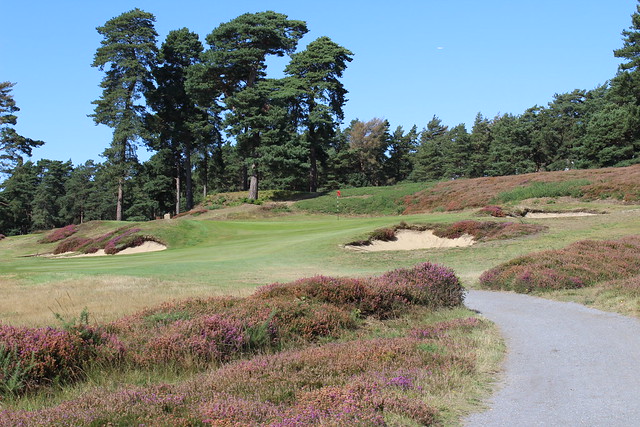
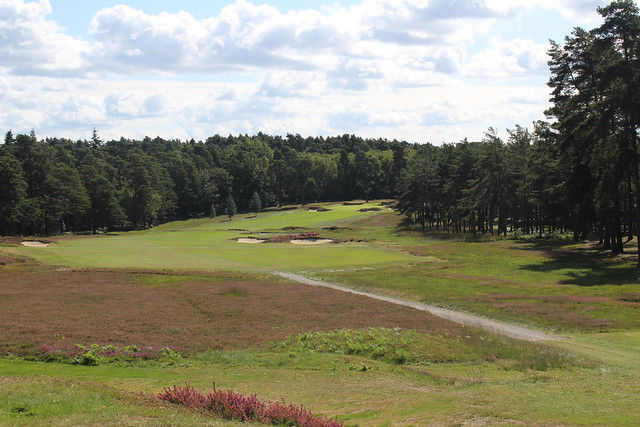

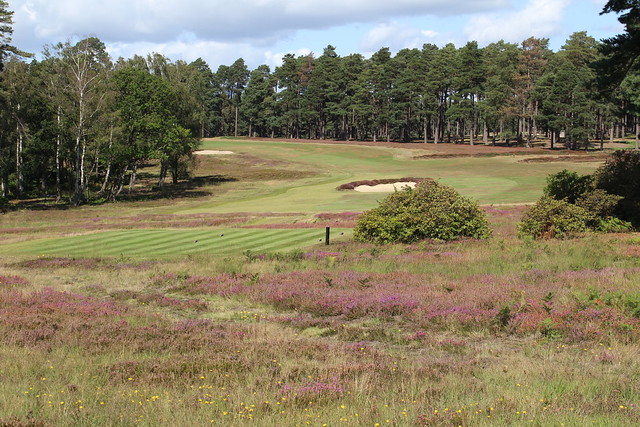

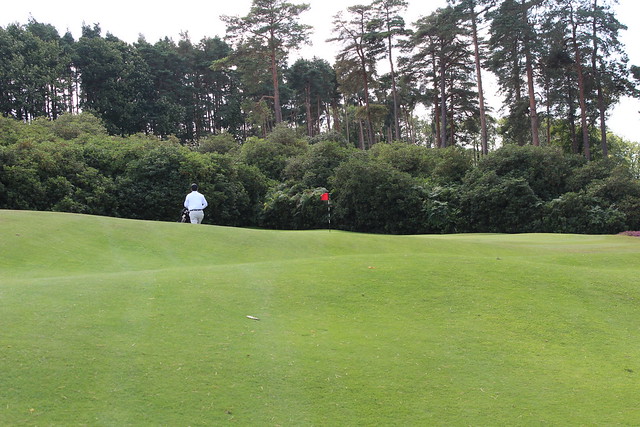

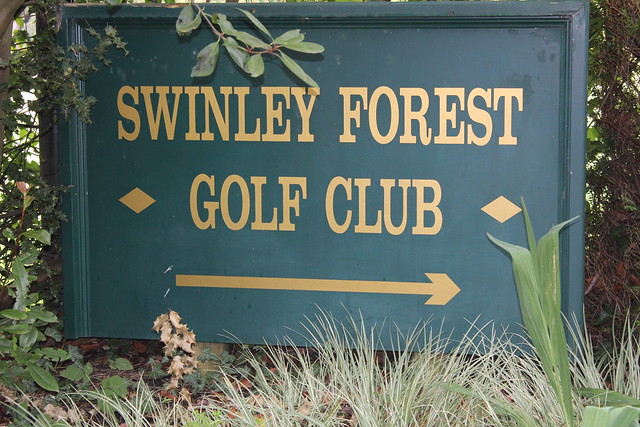




No comments:
Post a Comment